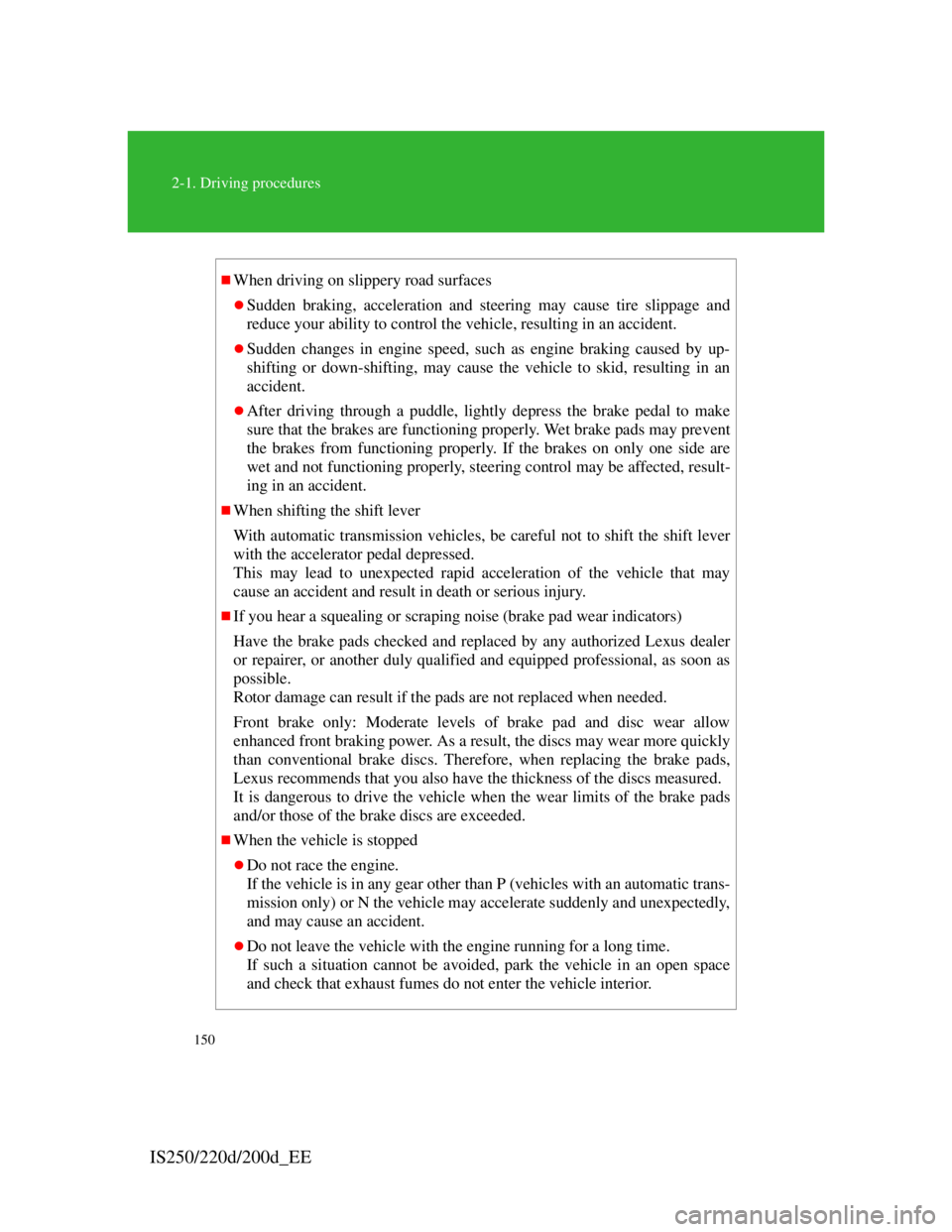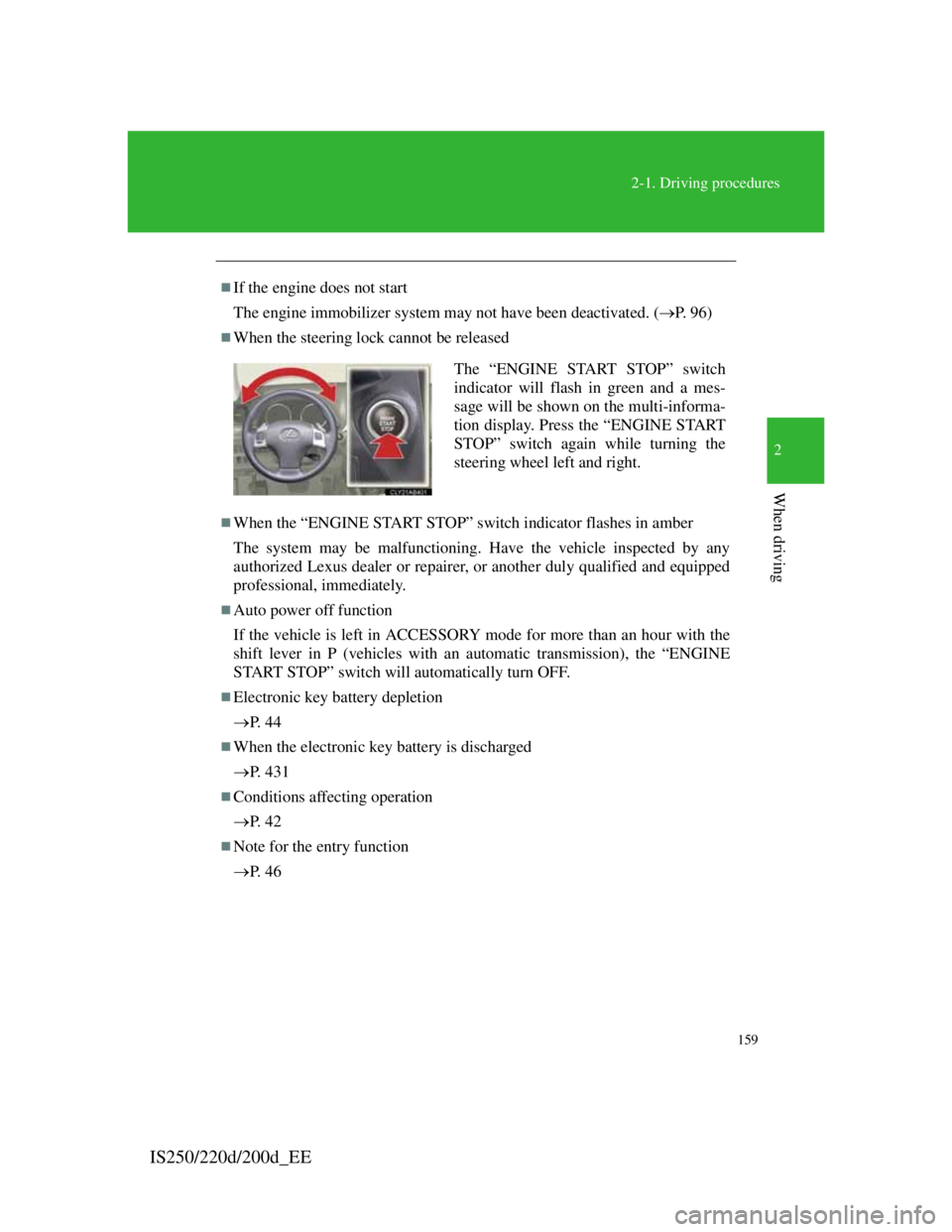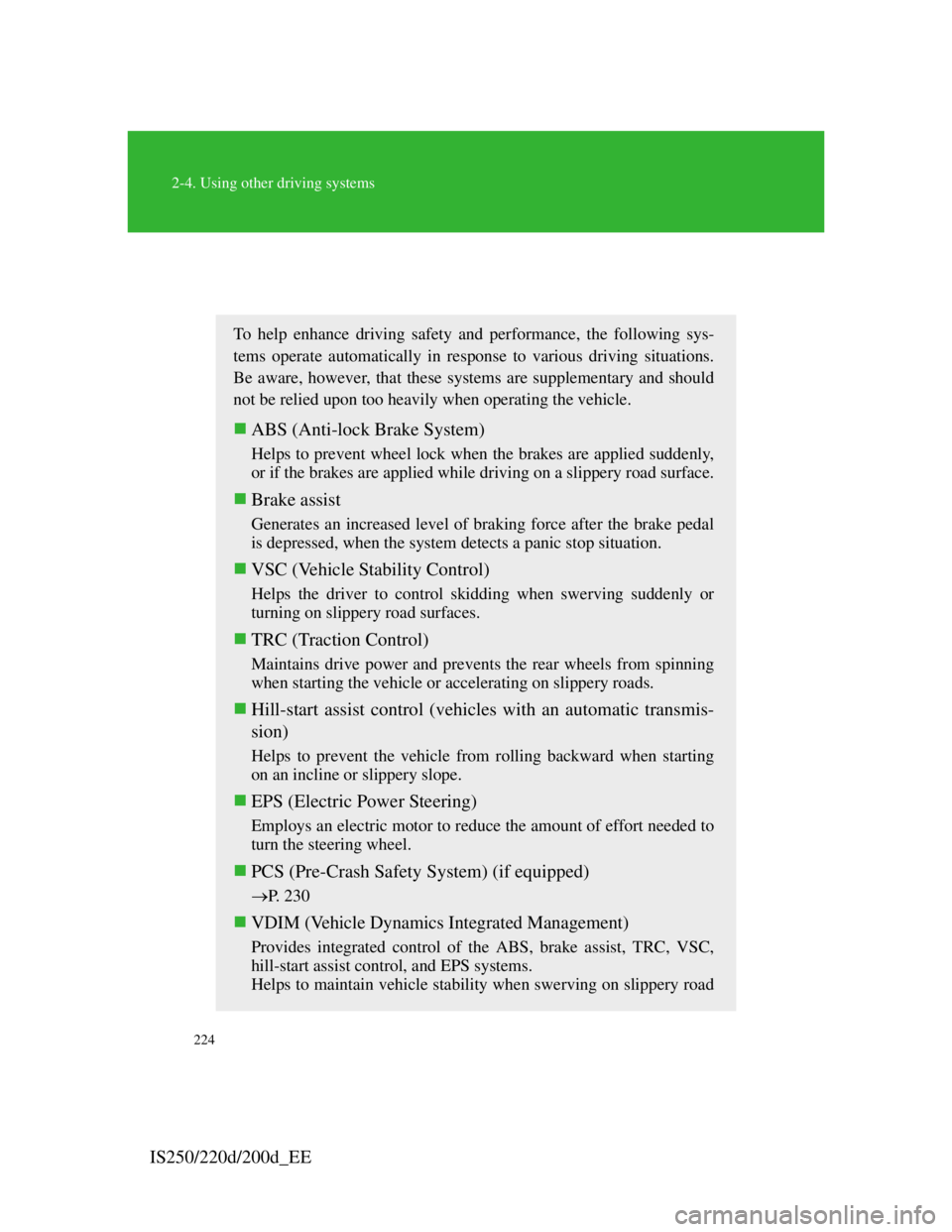steering Lexus IS220d 2012 Service Manual
[x] Cancel search | Manufacturer: LEXUS, Model Year: 2012, Model line: IS220d, Model: Lexus IS220d 2012Pages: 609, PDF Size: 14.63 MB
Page 159 of 609

150
2-1. Driving procedures
IS250/220d/200d_EE
When driving on slippery road surfaces
Sudden braking, acceleration and steering may cause tire slippage and
reduce your ability to control the vehicle, resulting in an accident.
Sudden changes in engine speed, such as engine braking caused by up-
shifting or down-shifting, may cause the vehicle to skid, resulting in an
accident.
After driving through a puddle, lightly depress the brake pedal to make
sure that the brakes are functioning properly. Wet brake pads may prevent
the brakes from functioning properly. If the brakes on only one side are
wet and not functioning properly, steering control may be affected, result-
ing in an accident.
When shifting the shift lever
With automatic transmission vehicles, be careful not to shift the shift lever
with the accelerator pedal depressed.
This may lead to unexpected rapid acceleration of the vehicle that may
cause an accident and result in death or serious injury.
If you hear a squealing or scraping noise (brake pad wear indicators)
Have the brake pads checked and replaced by any authorized Lexus dealer
or repairer, or another duly qualified and equipped professional, as soon as
possible.
Rotor damage can result if the pads are not replaced when needed.
Front brake only: Moderate levels of brake pad and disc wear allow
enhanced front braking power. As a result, the discs may wear more quickly
than conventional brake discs. Therefore, when replacing the brake pads,
Lexus recommends that you also have the thickness of the discs measured.
It is dangerous to drive the vehicle when the wear limits of the brake pads
and/or those of the brake discs are exceeded.
When the vehicle is stopped
Do not race the engine.
If the vehicle is in any gear other than P (vehicles with an automatic trans-
mission only) or N the vehicle may accelerate suddenly and unexpectedly,
and may cause an accident.
Do not leave the vehicle with the engine running for a long time.
If such a situation cannot be avoided, park the vehicle in an open space
and check that exhaust fumes do not enter the vehicle interior.
Page 163 of 609

154
2-1. Driving procedures
IS250/220d/200d_EE
NOTICE
When driving the vehicle
Do not depress the accelerator and brake pedals at the same time during
driving. If the brake pedal is depressed while driving with the accelerator
pedal depressed, driving torque may be restrained.
With automatic transmission vehicles
Do not use the accelerator pedal or depress the accelerator and brake ped-
als together to hold the vehicle on a hill.
With manual transmission vehicles
Do not rest your foot on the clutch pedal while driving.
Doing so may cause clutch trouble.
Do not use any gears other than the first gear when starting off and mov-
ing forward.
Doing so may damage the clutch.
Do not use the clutch to hold the vehicle when stopping on an uphill
grade.
Doing so may damage the clutch.
When parking the vehicle
With automatic transmission vehicles, always put the shift lever in P. Failure
to do so may cause the vehicle to move or the vehicle may accelerate sud-
denly if the accelerator pedal is accidentally depressed.
Avoiding damage to vehicle parts
Do not turn the steering wheel fully in either direction and hold it there for
a long time.
Doing so may damage the power steering motor.
When driving over bumps in the road, drive as slowly as possible to avoid
damaging the wheels, underside of the vehicle, etc.
IS220d and IS200d: Make sure to idle the engine immediately after high-
speed driving or hill climbing. Stop the engine only after the turbocharger
has cooled down.
Failure to do so may cause damage to the turbocharger.
Page 164 of 609

155
2-1. Driving procedures
2
When driving
IS250/220d/200d_EE
NOTICE
If you get a flat tire while driving
A flat or damaged tire may cause the following situations. Hold the steering
wheel firmly and gradually press the brake pedal to slow down the vehicle.
It may be difficult to control your vehicle.
The vehicle will make abnormal sounds.
The vehicle will behave abnormally.
Information on what to do in case of a flat tire (P. 485, 497)
When encountering flooded roads
Do not drive on a road that has flooded after heavy rain etc. Doing so may
cause the following serious damage to the vehicle.
Engine stalling
Short in electrical components
Engine damage caused by water immersion
In the event that you drive on a flooded road and the vehicle is flooded, be
sure to have any authorized Lexus dealer or repairer, or another duly quali-
fied and equipped professional check the following.
Brake function
Changes in quantity and quality of oil and fluid used for the engine, trans-
mission, differential, etc.
Lubricant condition for the propeller shaft, bearings and suspension joints
(where possible) and the function of all joints, bearings, etc.
Page 168 of 609

159
2-1. Driving procedures
2
When driving
IS250/220d/200d_EE
If the engine does not start
The engine immobilizer system may not have been deactivated. (P. 9 6 )
When the steering lock cannot be released
When the “ENGINE START STOP” switch indicator flashes in amber
The system may be malfunctioning. Have the vehicle inspected by any
authorized Lexus dealer or repairer, or another duly qualified and equipped
professional, immediately.
Auto power off function
If the vehicle is left in ACCESSORY mode for more than an hour with the
shift lever in P (vehicles with an automatic transmission), the “ENGINE
START STOP” switch will automatically turn OFF.
Electronic key battery depletion
P. 4 4
When the electronic key battery is discharged
P. 4 3 1
Conditions affecting operation
P. 4 2
Note for the entry function
P. 4 6
The “ENGINE START STOP” switch
indicator will flash in green and a mes-
sage will be shown on the multi-informa-
tion display. Press the “ENGINE START
STOP” switch again while turning the
steering wheel left and right.
Page 169 of 609

160
2-1. Driving procedures
IS250/220d/200d_EE
CAUTION
When starting the engine
Always start the engine while sitting in the driver's seat. Do not press the
accelerator while starting the engine under any circumstances.
Doing so may cause an accident resulting in death or serious injury.
Stopping the engine in an emergency
If you want to stop the engine in an emergency while driving the vehicle,
push and hold the “ENGINE START STOP” switch for more than 3 sec-
onds.
However, do not touch the “ENGINE START STOP” switch while driving
except in an emergency. Turning the engine off while driving will not cause
loss of steering or braking control, but the power assist to these systems will
be lost. This will make it more difficult to steer and brake, so you should
pull over and stop the vehicle as soon as it is safe to do so.
NOTICE
To prevent battery discharge
Do not leave the “ENGINE START STOP” switch in ACCESSORY or
IGNITION ON mode for long periods without the engine running.
When starting the engine
Do not race a cold engine.
If the engine becomes difficult to start or stalls frequently, have the engine
checked immediately.
Page 182 of 609

173
2-1. Driving procedures
2
When driving
IS250/220d/200d_EE
Horn
After adjusting the steering wheel (vehicles with manually adjustable steer-
ing wheel)
Make sure that the steering wheel is securely locked.
The horn may not sound if the steering wheel is not securely locked. (P.
79)
To sound the horn, press on
or close to the mark.
Page 228 of 609

216
2-4. Using other driving systems
IS250/220d/200d_EE
CAUTION
Conditions under which the vehicle-to-vehicle distance control may not
function correctly
Apply the brakes as necessary in the following conditions as the radar sen-
sor may not be able to correctly detect vehicles ahead, and a fatal or serious
accident may result:
When water or snow thrown up by the surrounding vehicles hinders the
functioning of the sensor
When your vehicle is pointing upwards (caused by a heavy load in the
trunk etc.)
When the road curves or when the lanes are narrow
When steering wheel operation or your position in the lane is unstable
When the vehicle ahead of you decelerates suddenly
Handling the radar sensor
Observe the following to ensure the cruise control system can function
effectively.
Otherwise, the system may not function correctly and could result in an
accident.
Keep the sensor and front grille cover clean at all times.
Clean the sensor and front grille cover with a soft cloth so you do not
mark or damage them.
Do not subject the sensor or surrounding area to a strong impact.
If the sensor moves even slightly off position, the system may malfunc-
tion. If the sensor or surrounding area is subject to a strong impact, always
have the area inspected and adjusted by any authorized Lexus dealer or
repairer, or another duly qualified and equipped professional.
Do not disassemble the sensor.
Do not attach accessories or stickers to the sensor, grille cover or sur-
rounding area.
Do not modify or paint the sensor and grille cover.
Do not replace them with non-genuine parts.
Page 236 of 609

224
2-4. Using other driving systems
IS250/220d/200d_EE
Driving assist systems
To help enhance driving safety and performance, the following sys-
tems operate automatically in response to various driving situations.
Be aware, however, that these systems are supplementary and should
not be relied upon too heavily when operating the vehicle.
ABS (Anti-lock Brake System)
Helps to prevent wheel lock when the brakes are applied suddenly,
or if the brakes are applied while driving on a slippery road surface.
Brake assist
Generates an increased level of braking force after the brake pedal
is depressed, when the system detects a panic stop situation.
VSC (Vehicle Stability Control)
Helps the driver to control skidding when swerving suddenly or
turning on slippery road surfaces.
TRC (Traction Control)
Maintains drive power and prevents the rear wheels from spinning
when starting the vehicle or accelerating on slippery roads.
Hill-start assist control (vehicles with an automatic transmis-
sion)
Helps to prevent the vehicle from rolling backward when starting
on an incline or slippery slope.
EPS (Electric Power Steering)
Employs an electric motor to reduce the amount of effort needed to
turn the steering wheel.
PCS (Pre-Crash Safety System) (if equipped)
P. 230
VDIM (Vehicle Dynamics Integrated Management)
Provides integrated control of the ABS, brake assist, TRC, VSC,
hill-start assist control, and EPS systems.
Helps to maintain vehicle stability when swerving on slippery road
Page 239 of 609

227
2-4. Using other driving systems
2
When driving
IS250/220d/200d_EE
Sounds and vibrations caused by the ABS, brake assist, VSC, TRC and hill-
start assist control systems
A sound may be heard from the engine compartment if the brake pedal is
depressed repeatedly when the engine is started or just after the vehicle
begins to move. This sound does not indicate that a malfunction has
occurred in any of these systems.
Any of the following conditions may occur when the above systems are
operating. None of these indicates that a malfunction has occurred.
• Vibrations may be felt through the vehicle body and steering.
• A motor sound may be heard after the vehicle comes to a stop.
• The brake pedal may pulsate slightly when the ABS is activated.
• The brake pedal may move down slightly after the ABS is activated.
Hill-start assist control is operational when
The shift lever is in the D or S position.
The brake pedal is not depressed.
The vehicle rolls backward.
EPS operation sound
When the steering wheel operates, a motor sound (whirring sound) may be
heard. This does not indicate a malfunction.
Reduced effectiveness of EPS
The effectiveness of EPS is reduced to prevent the system from overheating
when there is frequent steering input over an extended period of time. The
steering wheel may feel heavy as a result. Should this occur, refrain from
excessive steering input or stop the vehicle and turn the engine OFF. The
system should return to normal within 10 minutes.
If the slip indicator comes on
It may indicate a malfunction in the VSC, TRC or hill start assist control
function. Contact any authorized Lexus dealer or repairer, or another duly
qualified and equipped professional.
Page 252 of 609

238
2-5. Driving information
IS250/220d/200d_EE
CAUTION
Luggage capacity and distribution
Observe the following precautions. Failure to do so will not only put load on
the tires, but also reduce steering and braking performance. This could lead
to an accident resulting in serious injury or even death.
Do not overload the vehicle.
Do not apply load to the vehicle unevenly.